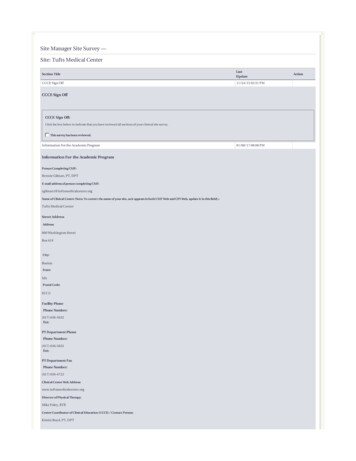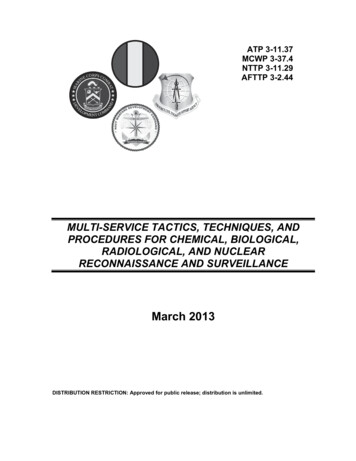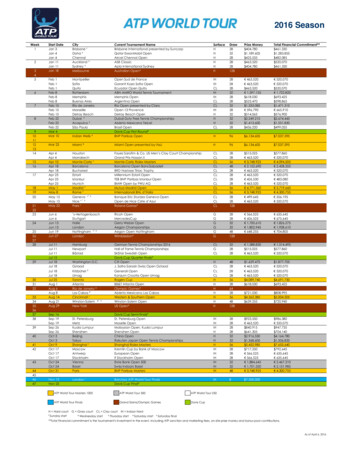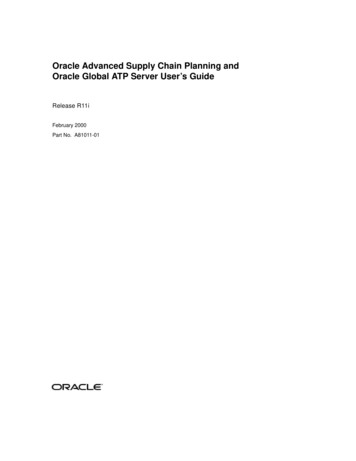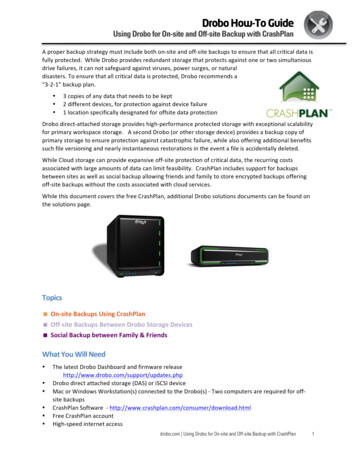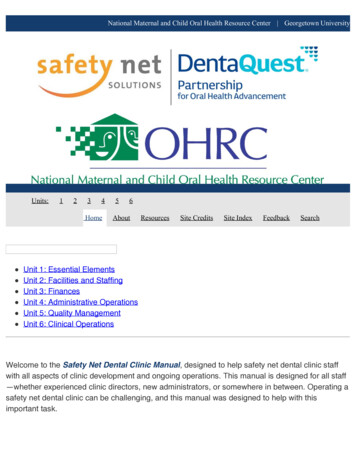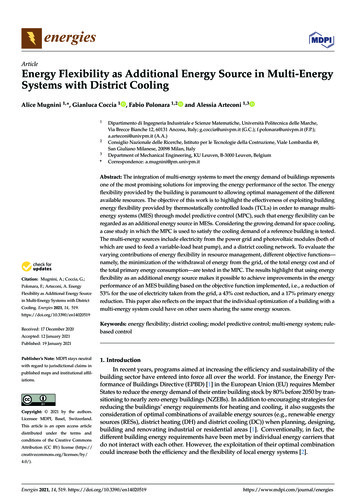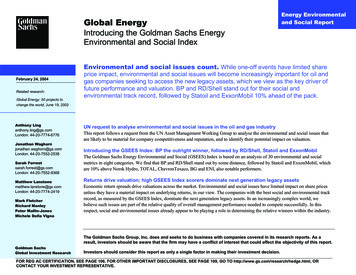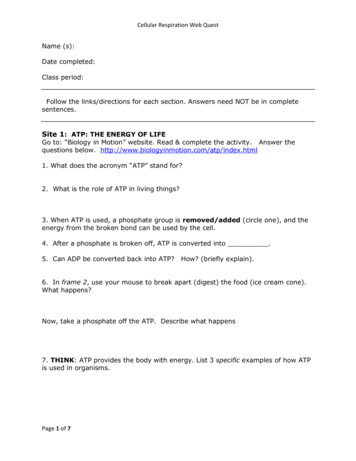
Transcription
Cellular Respiration Web QuestName (s):Date completed:Class period:Follow the links/directions for each section. Answers need NOT be in completesentences.Site 1: ATP: THE ENERGY OF LIFEGo to: “Biology in Motion” website. Read & complete the activity. Answer thequestions below. http://www.biologyinmotion.com/atp/index.html1. What does the acronym “ATP” stand for?2. What is the role of ATP in living things?3. When ATP is used, a phosphate group is removed/added (circle one), and theenergy from the broken bond can be used by the cell.4. After a phosphate is broken off, ATP is converted into .5. Can ADP be converted back into ATP?How? (briefly explain).6. In frame 2, use your mouse to break apart (digest) the food (ice cream cone).What happens?Now, take a phosphate off the ATP. Describe what happens7. THINK: ATP provides the body with energy. List 3 specific examples of how ATPis used in organisms.Page 1 of 7
Cellular Respiration Web QuestSite 2: How Cells Extract Energy From Complex page/cell respiration.htmRead through the information provided to answer the questions below.1. Write the chemical equation for aerobic cellular respiration.2. What are the three steps of cellular respiration?3. In the absence of sufficient oxygen, an alternative to the usual cellularrespiration steps is used. What is this process called?4. What is the energy yield (in terms of numbers of ATP molecules made) in theabove process (question 3), and how does is compare to the normal, aerobicrespiration energy yield?Sites 3&4: Anaerobic respiration (Fermentaion)Read about how and why anaerobic respiration (also called “fermentation”) takesplace in cells. cts/biology-edited/chap5/b0505601.aspSummary: When cells become oxygen-starved, they may be forced to break downtheir glucose only partially, with very little energy payoff. When this happens, theby-products differ.1. In which types of cells is lactate (lactic acid) produced as a result of anaerobicrespiration? Circle all that apply:animal cellshuman muscle cellsbacteriayeastplant cells2. In which types of cells is ethanol (ethyl alcohol) and CO2 produced as a result ofanaerobic respiration? Circle all that apply:animal cellsPage 2 of 7human muscle cellsbacteriayeastplant cells
Cellular Respiration Web Quest3. Commercial application of fermentation: List 5 industrial products of themicrobial fermentation activities.Site 5: Using Fermentation to make BiofuelsGo a/index.cfm?page biofuel home1. Using biofuels can reduce our reliance on traditional fossil fuels. What is anotheradvantage of using biofuels over gasoline in automobile engines?2. List 5 items that can be fermented to make ethanol biofuel.3. What crop is currently used to make the majority of biofuel ethanol in the U.S.?4. Nearly all of the gasoline currently sold in the U.S. is about % ethanol byvolume.5. What is “biodiesel”?Site 6: CELL RESPIRATION: A SUMMARYa) Go to About.com: Biology: Cellular Respiration. Read about ATP 90601a.htm1. How many ATPs are produced (total) in cellular respiration?Page 3 of 7
Cellular Respiration Web QuestSite content/cellularrespiration.htmlPut in your earbuds to listen to the audio while you watch the animations on thenext website. If you don’t have your earbuds, you can turn on the “subtitles”feature to read along. Answer the questions below as you view and listen.Part I: The Big Picture1. Name the specific internal chemical process (pathway) our bodies (and otherorganisms) use to break down food molecules and extract their energy?2. In the animation example, what are the inputs and outputs of cellularrespiration as the bison eats the grass?3. Cells capture and store the energy released from food in the bonds of what“plentiful, readily available” stored energy molecule?4. Cellular respiration is basically like which other process, in reverse?5. What are the three basic steps of cellular respiration?Part II: Glycolysis6. Specifically where, inside the cell, does glycolysis occur?7. TWO main things happen during glycolysis: is split in halfand a small amount of energy is released and captured in .8. To get glycolysis going (“uphill” phase), how many ATP molecules must be used?Summarize the processes in the “payoff” phase of glycolysis:9. First, the two glucose halves both attach to a high-energy phosphate group.The glucose then donates high-energy and ions (protons)to electron carries called NAD .Page 4 of 7
Cellular Respiration Web QuestThis results in two molecules of that are high-energy electroncarriers. These energy-carrying molecules are used later steps in cellularrespiration.10. Then, glycolysis continues and more bonds between the glucose molecules arebroken. Energy is recaptured by attaching phosphate groups to 2 molecules of, which creates energy-rich ATP. In addition, (how many) moleculesof water are produced.11. Finally, two more ADP molecules take the last two phosphate groups and maketwo more molecules.The glucose has now been broken down into two molecules of .12. Do the math: What is the “net” gain of ATP in glycolysis alone?Part III: The Krebs Cycle13. Where, inside the cell, does the Krebs cycle take place?14. To prepare for the Krebs cycle, the original two pyruvate molecules must bemodified into three new products. The products are twomolecules (which are exhaled), two molecules of (whichcarry more high-energy electrons, and protons), and two -CoA moleculeswhich will enter the Krebs cycle, one at a time.15. In the first step of the Krebs cycle, acetyl-CoA combines withand to form a six-carbon compound (citric acid).16. During the next stage of the Krebs cycle, the six-carbon compound is modifiedby the removal and addition of water, as well as the removal of two more CO2molecules. More electrons and protons are stripped off and added to twomolecules to form more energy-rich NADH molecules.17. In the third phase of the Krebs cycle, how many of each of the following aremade?ATP molecule(s)NADH molecule(s)FADH2 molecule(s)18. The final outcome of the Krebs cycle is the re-formation of the cycle’s startingmolecule, called , and then the cycle repeats one more time.Page 5 of 7
Cellular Respiration Web Quest19. SUMMARY – after both acetyl-CoA molecules (made from the original glucosemolecule) have been run through the Krebs cycle, what is the TOTAL number ofmolecules produced by the Krebs cycle?ATP molecule(s)NADH molecule(s)FADH2 molecule(s)20. Look at your answer to #9, above. How many NADH molecules were made inglycolysis? .21. Look at your answer to #14, above. How many NADH molecules were made inthe production of acetyl-CoA? .All of these high-energy, electron-carrying molecules will now bring their storedenergy into the final phase of respiration.Part IV: The Electron Transport Chain22. Where, inside the cell, is the electron transport chain located?23. NADH and FADH2 enter the electron transport chain after being created duringglycolysis and the Krebs cycle. Their role is to donate their extra to theelectron transport chain and go back to their original state, NAD and FAD. Then,they go back to participate in the Krebs cycle again.24. The potential energy from the electrons that are sent down the transport chainis used to pump protons (H ions) across the inner mitochondrial membrane,creating a (concentration difference),25. What gas is required for the electron transport chain (ETC) to operate?26. When oxygen picks up the electrons that have reached the end of the transportchain, and combines with protons, it forms what substance?27. Once a proton gradient is set up on one side of the mitochondrial membrane,protons will then be allowed to diffuse (“chemiosmose”) through special embeddedpassageways to the other side. This outward flow of protons provides the power tomake lots of .28. What will happen to Krebs and ETC if oxygen is not available?Extra credit: “Why is cyanide such a deadly poison?”Page 6 of 7
Cellular Respiration Web QuestSite 8: CELLULAR RESPIRATION: A CLOSER LOOKGo to “BioCoach Activity: Cell Respiration”. Click on each concepts and answer thefollowing questions.http://phschool.com/science/biology place/biocoach/cellresp/intro.html1. Click through Concepts 1 & 2. The function of the glycolysis stage is to splitglucose into two molecules of .2. Note how two molecules of ATP are used to drive glycolysis, yet the actualsplitting of glucose produces four ATPs. Do the math!What is the net gain of ATP?Now, Click on Concept 3. Read through the information on the Krebs (CitricAcid) Cycle. Click through the “Review” in the top right corner.3. Why is the Krebs cycle sometimes referred to as the “Citric acid cycle”? (Hint:look at the first product made in the cycle!)4. Explain why this process is called a “cycle”? (Hint: what is the starting andending molecule?)5. Click on Concept 4. Click through the “Review” in the top right corner.Briefly summarize the purpose of the Electron Transport Chain (in your own words).additional notes :pyruvate pyruvic acidcitrate citric acidoxaloacetate oxaloacetic acidPage 7 of 7
carriers. These energy-carrying molecules are used later steps in cellular respiration. 10. Then, glycolysis continues and more bonds between the glucose molecules are broken. Energy is recaptured by attaching phosphate groups to 2 molecules of _, which creates energy-rich ATP. In addition, _ (how many) molecules of water are produced .
